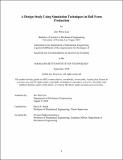A Design Study Using Simulation Techniques in Roll Form Production
Author(s)
Lee, Joo Won
DownloadThesis PDF (25.43Mb)
Advisor
Hardt, David E.
Terms of use
Metadata
Show full item recordAbstract
Sheet metal roll forming is a continuous bending process where metal strips are fed through a sequence of rolls to achieve a specific cross-sectional profile. This method is vital in the automotive industry for producing high-strength, lightweight components with precision, consistency, and cost-efficiency. This project focuses on optimizing Novelis’s aluminum roll forming process using Computer-Aided Engineering (CAE) techniques, including UBECO Profil, AutoCAD, and Finite Element Analysis (FEA) tools such as Ansys and LS-Dyna. Initial simulations on a square tube profile were key in identifying critical stations, leading to performance improvements through targeted adjustments. Stress and strain analyses revealed how operational factors, such as roll adjustments, affect the section shapes and angles, facilitating the refinement of roll forming station settings. With a Design of Experiment (DOE) framework, the study identified key variables to enhance simulation output accuracy and optimize roll forming settings. The team successfully built a digital twin of the new roll forming line, which accurately predicted the final product's geometry and provided precise recommendations for machine settings to achieve the desired shape. Novelis can apply these insights to enhance their software, thereby potentially increasing production efficiency. This approach not only supports current operations but also lays the foundation for future research and development advancements.
Date issued
2024-09Department
Massachusetts Institute of Technology. Department of Mechanical EngineeringPublisher
Massachusetts Institute of Technology